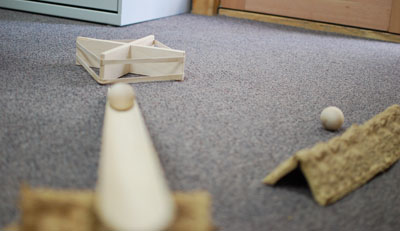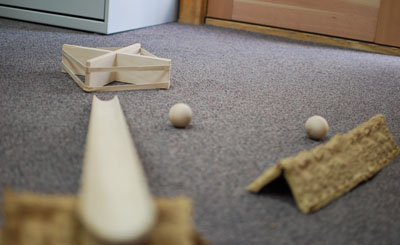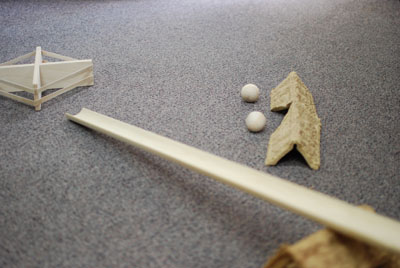This fall we have been thinking about how to provide depth within the realm of STEM, specifically within Engineering. In this second email of our fall email series, we will explore how to add another mathematical concept to ramp play with the use of deflectors.
The Deflector Set is intended for use in the classroom as an accessory to our Discovery Ramps, their purpose is to help children develop an understanding of deflection. What makes a super bounce ball shoot off the wall at such an angle, or why does a rock skip across the water? The answer is deflection. While most children have bounced balls, few have focused their attention on really understanding what is happening. The basis of deflection is outlined in Newtons three Laws of Motion. As an object moves toward a stationary surface, the angle it deflects off that surface is equal to the angle at which it approaches the surface. The ball is deflected (bounces) off a fixed surface because the surface does not absorb all of the balls force. That energy is redirected back into the ball by the surface, thus forcing it in the opposite direction. The new direction is determined by the angle of incidence.
Yes, this concept is complex; however, understanding the overarching concept is important so we may help children learn these concepts through their daily experiences. Study this diagram, then go bounce a ball. We believe the many concepts illustrated here will be understood quite simply by children through real life experience.
In addition, deflection has far reaching implications in everyday life. Beyond the ping pong table (and Angry Birds!!), it can be found in many sports such as soccer and tennis. Deflection is at work in the bumper car arena, the pinball machine, hammering a nail, and many other scenarios where two objects are physically interacting. Deflection is present when you look into a mirror. The light from the object (the image) is deflecting off the mirrored surface and enters your eye. If you could take a ball and throw it from your eye to the mirror it would deflect off the mirror and hit the object which you see in the mirror.
Illustrate this concept through an activity!
Materials: a ramp, ball, deflector, and small mirror.
Place the mirror up against the deflector so that the deflector and mirror are flush together. Set up the ramp to roll the ball into the deflector. Aim the deflector so as you look down the ramp, the goal of where you want the ball to go is reflected in the mirror. Remove the mirror and launch the ball. What happens?



Deflection is at the center of many child activities at home and in the classroom. Whether you are a teacher or parent, helping your children understand basic physics will support their work as scientists and engineers. If you’re not familiar with the concept of deflection, we suggest you plan a time to experiment yourself. You’ll soon be having fun discovering new ways that you and your children can think together! Before you know it, you’ll all be bouncing ideas off one another. (Pun totally intended!)
Here is some advanced vocabulary to expand the experience:
bounce, deflect, angle of incidence, projectile, vector, force, slope, gravity, momentum
We hope this helps to inspire your Engineering experience!
Thanks for reading!


